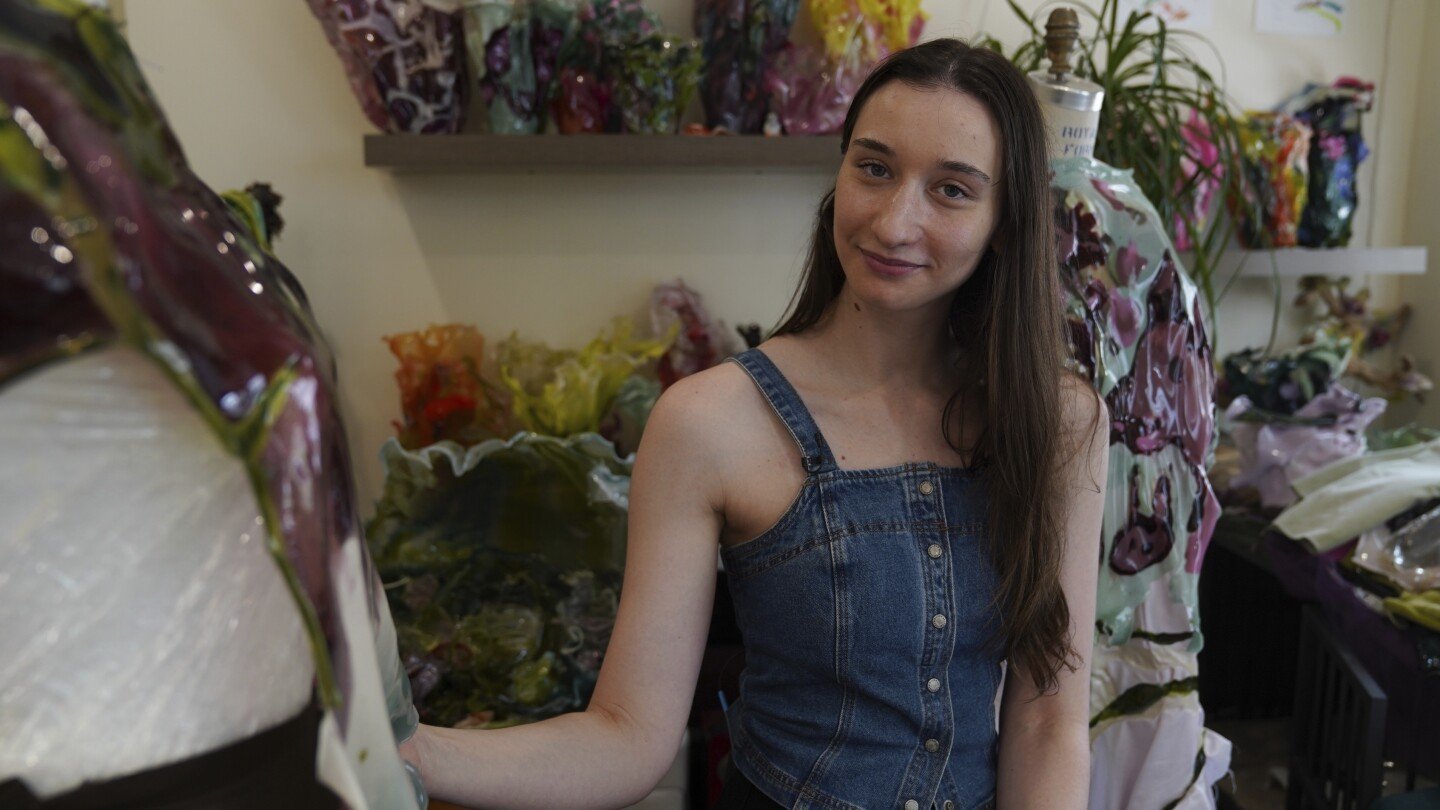Lifestyle
New Orthodox saint was an Alaska Native now known as St. Olga

KWETHLUK, Alaska (AP) — “St. Olga of Kwethluk, Matushka of All Alaska,” as she is officially known, was canonized on June 19 as the first female Orthodox saint from North America.
Orthodoxy — the world’s second-largest Christian communion — gained a foothold in the present-day United States with the 18th and 19th century arrival of Russian Orthodox missionaries to what was then the czarist territory of Alaska.
While the Orthodox are a small minority within the Christian population in the state and the nation, Alaska is often considered a holy land for the now-independent Orthodox Church in America.
Who is St. Olga of Kwethluk?
Olga Michael was born in 1916 in Kwethluk, where she resided her entire life with her Yup’ik family and neighbors. The Yup’ik, like the Tlingit, Inupiat and Aleuts, are broadly called Alaska Natives. The town’s name is derived from the Yup’ik term for “dangerous river.”
Her Yup’ik name was Arrsamquq; she was confirmed in the church under the name Olga.
Like other villagers, her life followed the seasonal rhythms of subsistence living, preparing food at “fish camps” for preservation and making clothing from animal skins.
She married Nicolai Michael, who became an Orthodox priest. They had 13 children, five of whom died in childhood, a tragically familiar occurrence at a time when epidemics were common.
Matushka, from the Russian for mother, is a term of respect for Orthodox priest’s wives. “Matushka Olga” fulfilled that role of spiritual mother — counseling women who had suffered abuse or griefs such as miscarriage — and she was widely admired for her compassion and piety, often providing other people with food and handmade clothing.
Matushka Olga was also a midwife, delivering many children.
And when she died of cancer on Nov. 8, 1979, villagers reported that unseasonably warm weather thawed the river ice, enabling people to travel by boat from other villages to her funeral, according to an official church biography.
What does her family say?
“She was the most prominent adult in my life,” recalled Wiz Ruppert, who was raised in Matushka Olga’s home from about three to 13, when her grandmother died. “Without her, I think my life would have been so different.”
Like other family members, Ruppert recalls Olga never raising her voice.
“If I had a hard time waking up, she would nudge me, and if I didn’t wake up, she would gently carry me to a chair where breakfast was ready,” Ruppert recalled.
She recalled the fresh bread her grandmother would make, how she patiently taught her how to prepare freshly caught fish, how she would sew fur boots with sealskin soles for others in the community.
“Those are really hard to work on,” Ruppert recalled. “I would watch her chew the soles so they would be soft enough to sew.”
How did devotion to St. Olga grow?
After her death, devotion to Matushka Olga spread beyond Alaska to Orthodox faithful in distant states and countries. She’s often depicted in unofficial icons framed by northern lights, with the words, “God can create great beauty from complete desolation.”
People began to report encounters with Matushka Olga in sacred dreams and visions, according to the church. One poignant account of a woman who had suffered childhood sexual abuse describes a profoundly healing experience during a prayerful encounter with Olga.
In 2023, the groundswell of devotion eventually prompted the Holy Synod of Bishops of the Orthodox Church in America to approve her “glorification” as a saint.
What happens next?
Kwethluk, with a population of about 800 and accessible only by boat or small plane, now anticipates receiving pilgrims.
The Diocese of Alaska is in the early stages of working with the village on plans and fundraising for a new church, hospitality center and cultural center.
“We have gotten some pilgrims already, although not in force yet, but we expect them to come regularly after this summer,” said the Rev. Martin Nicolai, a retired priest attached to St. Nicholas Church. “People who venerate her as a saint will want to come and pray beside her relics.”
How are saints formally recognized?
Orthodox have a similar process to Catholics in determining saints.
It begins with grassroots devotion. Eventually petitions reach the highest authority — in Orthodoxy, a synod of bishops; in Catholicism, the pope — to make the determination. Sainthood becomes official with a service of canonization or glorification.
There are multiple Orthodox jurisdictions in the United States and internationally. They generally recognize each other’s saints.
Why is Alaska considered an Orthodox holy land?
Several Orthodox monks and martyrs with ties to Alaska are already recognized as saints by the Orthodox Church in America, the now-independent offspring of the Russian Orthodox Church. Pilgrims come to Alaska to venerate their relics at their shrines.
St. Olga is the third with Alaska Native heritage recognized by the Orthodox Church in America, following the 19th century St. Peter the Aleut and St. Yakov Netsvetov of Alaska, who was of Aleut and Russian heritage. Most of the state’s Orthodox priests, serving about 80 parishes, are Alaska Natives. More than a dozen priests have come from Kwethluk.
How are Orthodox churches organized?
Eastern Orthodox churches trace their roots to the beginning of Christianity. Several are self-governing, with their leaders considered equals, and they share beliefs and sacraments while cooperating in charitable and other activities.
In the United States, organizational lines are rooted in the national backgrounds of various ethnic groups, such as the Orthodox Church in America (with roots in Russian Orthodoxy) and the Greek Orthodox Archdiocese of America. But many U.S. churches now have members of varied ancestries, and cooperate through the Assembly of Canonical Orthodox Bishops.
___
Associated Press religion coverage receives support through the AP’s collaboration with The Conversation US, with funding from Lilly Endowment Inc. The AP is solely responsible for this content.
Lifestyle
Man charged after kilt-wearing attacker smashes case holding Scotland’s Stone of Destiny

LONDON (AP) — A man from Australia has been charged with “malicious mischief” for allegedly smashing a glass case holding the Stone of Destiny, an ancient symbol of Scottish nationhood.
Arnaud Harixcalde Logan, 35, appeared at Perth Sheriff Court on Monday to face the charge, which is similar to vandalism.
Logan, whose address was given as Sydney, wasn’t asked to enter a plea and was ordered detained until a hearing next week.
Police said that they were called to a “disturbance” at Perth Museum in central Scotland on Saturday, after reports of a kilt-wearing man attempting to smash the case containing the royal rock.
The 335-pound (150-kilogram) sandstone block is also known as the Stone of Scone (Skoon) — and was used in the crowning ceremonies of medieval Scottish monarchs at Scone Abbey, near Perth. It was stolen by England’s King Edward I in the 13th century and taken to Westminster Abbey in London, where it was installed under the seat of the coronation chair.
It has been used in coronations at the abbey ever since — first of English and then of British monarchs The English and Scottish crowns were united under one monarch in the 17th century.
The stone’s presence in London long irked Scottish nationalists. In 1950, it was stolen from Westminster Abbey by four Glasgow university students, but was returned in time for the coronation of Queen Elizabeth II in 1953.
It was given back to Scotland in 1996, 700 years after its seizure, and displayed in Edinburgh Castle, with the understanding that it would return to England for use in future coronations. Sensitivities around the stone meant that it had to be moved to London in secrecy and amid tight security for the coronation of King Charles III in 2023.
Last year it was put on display at the newly renovated Perth Museum where, according to the building’s website, there are “a range of 24/7 security measures in place at the Museum to protect this precious object.”
Culture Perth and Kinross, which oversees the museum, said the stone wasn’t damaged in the incident.
Lifestyle
These flavor-packed pork burgers were inspired by Indian street food

These flavor-packed burgers are a spin on a spiced pork sausage from Goa in southern India, based on the garlicky, European-style chouriço introduced by Portuguese settlers. To combat the humidity of the region and prolong the shelf life of the sausage, the meat is heavily salted and flavored with a mixture of spices and tangy vinegar.
Goan sausage is ubiquitous in southern India, where you can find it sold at street food carts and high-end restaurants alike, sometimes baked into a bun or minced and stuffed between layers of fried naan.
In this recipe from our cookbook “ Milk Street 365: The All-Purpose Cookbook for Every Day of the Year,” we take inspiration from those burger-like sandwiches, using a combination of grated garlic, garam masala, cumin, paprika and cayenne to give the all-pork patties deep, complex flavor and a rusty hue. Grating the garlic ensures it melts into the meat without any distracting bits. Instead of naan, we use classic hamburger buns.
Egg and panko bread crumbs help the patties keep their shape. Don’t undermix the pork mixture; be sure to combine it well so the breadcrumbs and seasonings are evenly distributed.
These burgers are especially delicious topped with yogurt, torn fresh mint leaves and thin slices of cucumber or tomato.
Start to finish: 35 minutes
Servings: 4
Ingredients:
⅔ cup panko breadcrumbs
¼ cup plain whole-milk yogurt, plus more to serve
5 teaspoons garam masala
5 teaspoons sweet paprika
1 tablespoon ground cumin
½ teaspoon cayenne pepper
2 large egg yolks
2 medium garlic cloves, finely grated
Kosher salt and ground black pepper
1 pound ground pork
2 tablespoons grapeseed or other neutral oil
4 hamburger buns, toasted
Directions:
In a large bowl, combine the panko, yogurt, garam masala, paprika, cumin, cayenne, egg yolks, garlic, ¾ teaspoon salt, ½ teaspoon pepper and ¼ cup water. Using a fork, mash the mixture into a smooth paste. Add the pork and mix with your hands until evenly combined. Form into 4 patties, each about 4 inches in diameter, place on a large plate and refrigerate for 15 minutes.
In a 12-inch nonstick skillet over medium, heat the oil until barely smoking. Add the burgers and cook until well browned, 7 to 8 minutes. Flip, reduce to medium-low and continue to cook until the patties are well browned on the second sides and the centers reach 160°F, another 5 to 7 minutes. Transfer to a clean plate, tent with foil and let rest for 5 minutes. Serve on the buns with additional yogurt on the side.
EDITOR’S NOTE: For more recipes, go to Christopher Kimball’s Milk Street at 177milkstreet.com/ap
Lifestyle
Fashion designers experiment with natural supplies called biomaterials

NEW YORK (AP) — At her kitchen stove, fashion designer Caroline Zimbalist looks like an alchemist at work as she stirs a pot full of corn starch and a thickener made from seaweed. The peppermint-scented mixture glitters as she carefully pours it into silicone molds of hearts and leaves.
When the material hardens, Zimbalist will stitch it into unique, made-to-order dresses that she sells on her website. She hopes her designs, which have been worn by celebrities including Chappell Roan, will put a spotlight on materials that aren’t sourced from planet-polluting fossil fuels, such as oil.
“It’s almost like a vessel to show the world,” she said.
Other small-scale designers are testing out tapioca, gelatin and other kitchen-shelf ingredients. Meanwhile, big names such as Adidas and Hermes have experimented with mushroom leather, while the Lycra brand is incorporating a new largely corn-based material into stretch fabric. Some experts are skeptical that these textiles — commonly referred to as biomaterials — will go mainstream, but designers such as Zimbalist hope their experiments will set an example for larger brands to follow.
Over 60% of clothing comes from petroleum-based synthetics like polyester, according to Textile Exchange, a nonprofit that promotes sustainable fashion. Manufacturing those materials creates emissions. Synthetic garments can also shed microplastics during washing. And as fast-fashion brands pump out new clothes for customers who expect new designs every few weeks, many garments end up in landfills.
A piece by fashion designer Caroline Zimbalist is displayed on Friday, June 6, 2025, in the Queens borough of New York. (AP Photo/Mary Conlon)
Zimbalist’s designs gained attention in 2024 when Roan wore one on “The Tonight Show.” The New York-based designer has since dressed stars such as comedian Atsuko Okatsuka and actors Anna Lore and Reneé Rapp. She takes commissions for custom clothing pieces, which cost between $150 and $1,200, via her website, which notes her “unique recipe of biodegradable and natural materials.”
As to whether her approach could be reproduced at a larger scale, Zimbalist says her materials could most practically be used to replace plastic hardware such as buttons and zippers. She acknowledges they can be sticky if not dried correctly, stinky if not treated and melty if exposed to extreme heat.
“Even incorporating it in small ways to start would be really strong,” she said.
Why biomaterials are hard to find
Fossil-fuel derived fabrics are ubiquitous because they’re cheap and made from plentiful raw materials, said Dale Rogers, an Arizona State University professor who studies supply chains.
Many clothes are also made of materials that come from plants or animals such as cotton, silk, wool and cashmere. But some have environmental impacts. Cotton uses a lot of water. Sheep and goats burp out methane.
Some biomaterials have gotten closer to widespread use. Mycelium leather, made from mushrooms, has been used to create luxury shoes, accessories and handbags by brands such as Stella McCartney, Lululemon, Adidas and Hermes.
Still, Rogers said he’s not convinced there’s enough demand for alternative materials to overcome companies’ aversion to the higher costs of producing them at a large scale.
“Honestly, in the end, cost drives almost all decisions,” he said.
Wrinkles in aiming for sustainability
Getting larger companies to use alternative materials depends on whether they will pay more for a fabric that matches their values, said Jon Veldhouse, the CEO of Qore LLC.
His company makes a product called Qira that replaces about 70% of the fossil-derived components of elastic synthetic fabrics with a corn-based material. The Lycra Company, which sells its stretchy material to major brands, initially expects to incorporate Qira in around 25 percent of its Spandex business, said Lycra chief brand and innovation officer Steve Stewart. But that option will be more expensive, and they haven’t yet announced any takers.
It can also be hard to measure the sustainability of farming practices that go into producing raw materials for new fabrics. Cargill is Qore’s partner and corn supplier, and it gets its grain from farmers in the vicinity of their processing plant. Veldhouse said many already plant cover crops or reduce tilling to lower environmental impact, but he couldn’t provide data on how many use those approaches.
Sarah Needham, a senior director at Textile Exchange, said it’s great to see a large organization such as Lycra making its production systems more sustainable. But she also stressed the industry needs to reduce its overreliance on virgin materials, perhaps considering agricultural waste as a source of fabric.
The role of experimental designers
Needham said experimental designers are often the ones coming up with those alternatives to virgin materials and building appetite for new approaches.
But small designers might not have the resources to test the biodegradability of their materials, which often do involve processing, even if it’s by hand, said Ramani Narayan, an engineering professor at Michigan State University.
“If I take something — like seaweed or whatever it is — and I apply a process to it, then I can no longer call it natural,” he said.
Zimbalist, the New York designer, acknowledges that her materials aren’t ready to replace conventional fabrics and that her work is more of “a piece that leads to larger conversations.”
Rogers, of Arizona State, thinks the fashion industry is a long way from meaningful change, but that “it’s incredibly valuable” for artists and specialty manufacturers to try new materials.
“What they’re doing is likely to have long-term benefit, maybe even after their lifetimes,” he added.
___
Follow Melina Walling on X @MelinaWalling and Bluesky @melinawalling.bsky.social.
Follow Kiki Sideris on X @KikiSideris.
___
The Associated Press’ climate and environmental coverage receives financial support from multiple private foundations. AP is solely responsible for all content. Find AP’s standards for working with philanthropies, a list of supporters and funded coverage areas at AP.org.
-

 Europe5 days ago
Europe5 days agoBondi and Hegseth might be messing up — but they’re doing what Trump picked them to do
-

 Sports3 days ago
Sports3 days agoBill Ackman: Swift backlash after billionaire’s pro debut
-

 Lifestyle4 days ago
Lifestyle4 days agoSebeiba festival in Algeria carries on ancient tradition
-

 Europe3 days ago
Europe3 days agoGerman tourist found alive 12 days after she was lost in the Australian Outback
-

 Africa5 days ago
Africa5 days agoGreece blocks asylum claims after surge in migrant arrivals
-

 Lifestyle4 days ago
Lifestyle4 days agoHealthy workday snacks include a smart mix of energy-boosters
-

 Lifestyle3 days ago
Lifestyle3 days agoOne Tech Tip: All the ways to unsubscribe, after ‘click-to-cancel’ was blocked
-

 Sports3 days ago
Sports3 days agoMarc and Álex Márquez: Two brothers, one title dream – MotoGP’s high stakes sibling rivalry




